Within this post we talk about the development of a 2000 watt inverter circuit which includes a ferrite core transformer thereby is significantly portable than the standard iron core alternatives.
Very first you have to discover 60V DC power supply for operating the offered 2kVA inverter circuit. The purpose is to design a switching inverter which is able to allow change the DC voltage of 60V to a higher 220V at a reduced current. The topology implemented in this particular situation is the push-pull topology which utilizes transformer on the ratio of 5:18.
For voltage control which you will require, and the current limit – they may be all powered by an input voltage source. Additionally at the similar rate, the inverter expedites the current permitted. With regards to an input source of 20A you may get 2 – 5A. In spite of this, the peak output voltage of this 5kva inverter is approximately 220V.
Pertaining to the architecture, Tr1 transformer has 5+5 primary turns and 18 for secondary. For switching, you are able to utilize 4+4 MOSFET (IXFH50N20 type (50A, 200V, 45mR, Cg = 4400pF). You will be also free to employ MOSFET of any voltage with Uds 200V (150V) together with least conductive resistance. The gate resistance utilized and its effectiveness in speed and capacity needs to be excellent.
The Tr1 ferrite section is designed around 15x15 mm ferrite c. The L1 inductor was created utilizing five iron powder rings that could be wound as wires. For inductor core as well as other connected parts, you could always get it from old inverters (56v/5V) and within their snubber phases.
For built-in circuit the IC IR2153 may be deployed. The outputs of the ICs could possibly be observed buffered with BJT levels. Furthermore, as a result of the large gate capacitance included it is essential to utilize the buffers by means of power amplifier complementary pairs, several of BD139 and BD140 NPN / PNP transistors perform the job nicely.
You can even make sure to make use of other control circuits like SG3525. Also, it is possible to modify the voltage of the input and operate in direct connection with the mains for assessment purpose. The topology utilized in this circuit has the facility of galvanic isolation and working frequency is around 40 kHz. If you find you might have planned to utilize the inverter for a small operation, you don’t cooling, but for longer operation make sure to add a cooling agent making use of fans or large heatsinks. The majority of the power is lost at the output diodes and the Schottky voltage goes low around 0.5V.
The input 60V may very well be obtained by putting 5 nos of 12Vbatteries in series, the AH rating of each battery ought to be graded at 100 AH

The 220V acquired at the output of TR1 in the above 5kav inverter circuit still simply cannot be useful for working regular appliances since the AC content could well be oscillating at the input 40kHz frequency.
For transforming the above 40 kHz 220V AC into 220V 50 Hz or a 120V 60Hz AC, additional phases could be needed as mentioned below:
Initially the 220V 40kHz will have to be rectified/filtered by means of a bridge rectifier comprised of fast recovery diodes rated at around 25 amps 300V and 10uF/400V capacitors.
Subsequent, this repaired voltage which might now build to around 310V will have to be pulsed at the demanded 50 or 60 Hz by way of another full bridge inverter circuit as demonstrated below:

The terminals marked "load" could possibly be right now instantly employed as the final output for running the preferred load.
Right here the mosfets may very well be IRF840 or any parallel type will do.
Tips on how to Wind the Ferrite Transformer TR1
The transformer TR1 is the main device which can be accountable for upgrading the voltage to 220V at 5kva, being ferrite cored based it's designed over a number of ferrite EE cores as detailed below:
Considering that the power engaged is substantial at around 5kvs, the E cores ought to be impressive in size, an E80 type ferrite E-core might be attempted.
Be aware of you might have to include a lot more than 1 E core, may be 2 or 3 E-cores with each other, positioned side by side for attaining the enormous 2KVA power output from the assembly.
Make use of the largest one that might be accessible and wind the 5+5 turns utilizing 10 numbers of 20 SWG super enameled copper wire, in parallel.
After 5 turns, stop the primary winding insulate the layer with an insulating tape and start the secondary 18 turns over this 5 primary turns. Utilize 5 strands of 25 SWG super enameled copper in parallel for winding the secondary turns.
As soon as the 18 turns are finalized, terminate it across the output leads of the bobbin, insulate with tape and wind the remaining 5 primary turns over it to carried out the ferrite cored TR1 construction. Do not overlook to join the end of the first 5 turns with the start of the top 5 turn primary winding.
E-Core Set up Technique
The following diagram provides a concept concerning how greater than 1 E-core can be utilized for applying the above mentioned 2 KVA ferrite inverter transformer design:











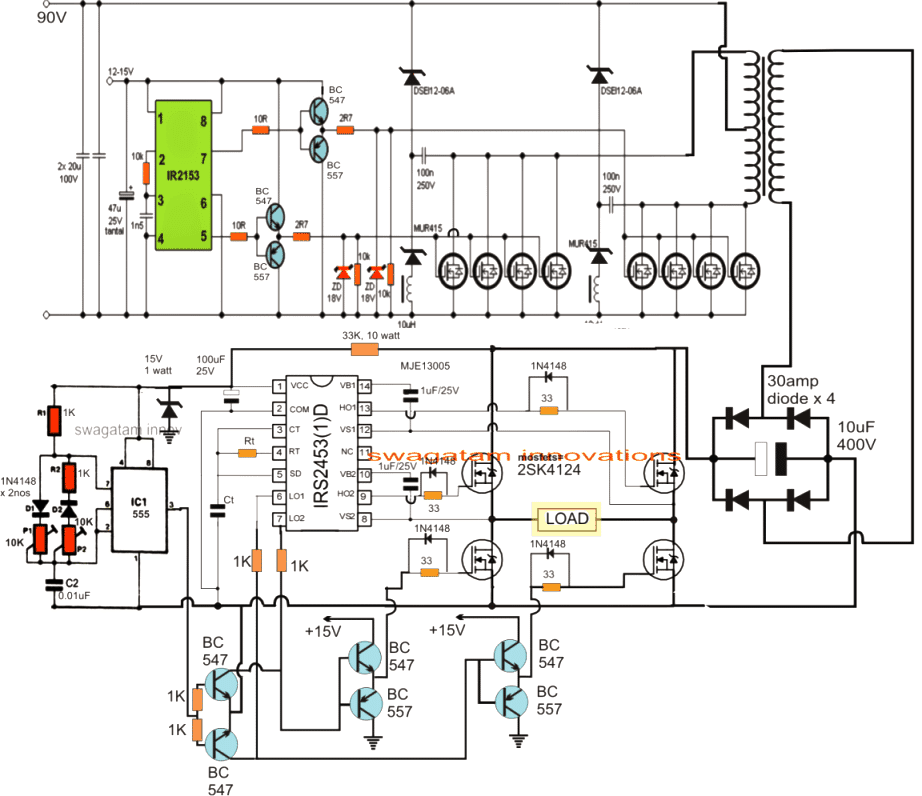
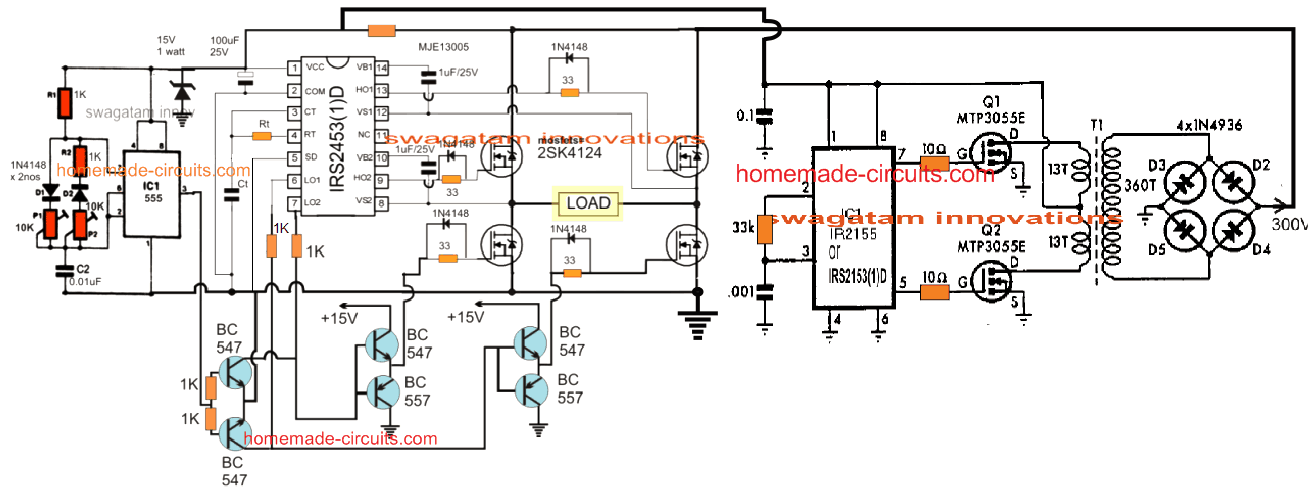
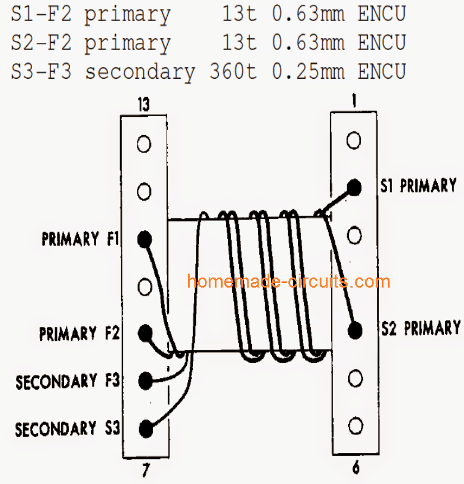
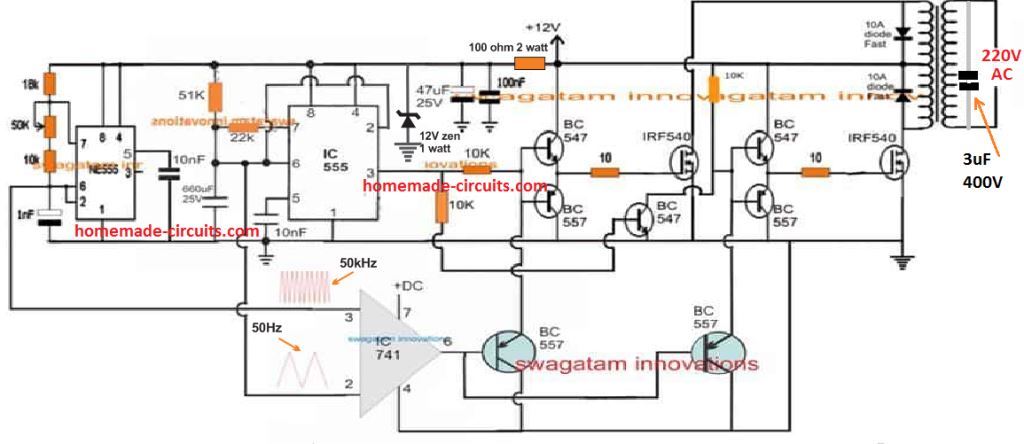
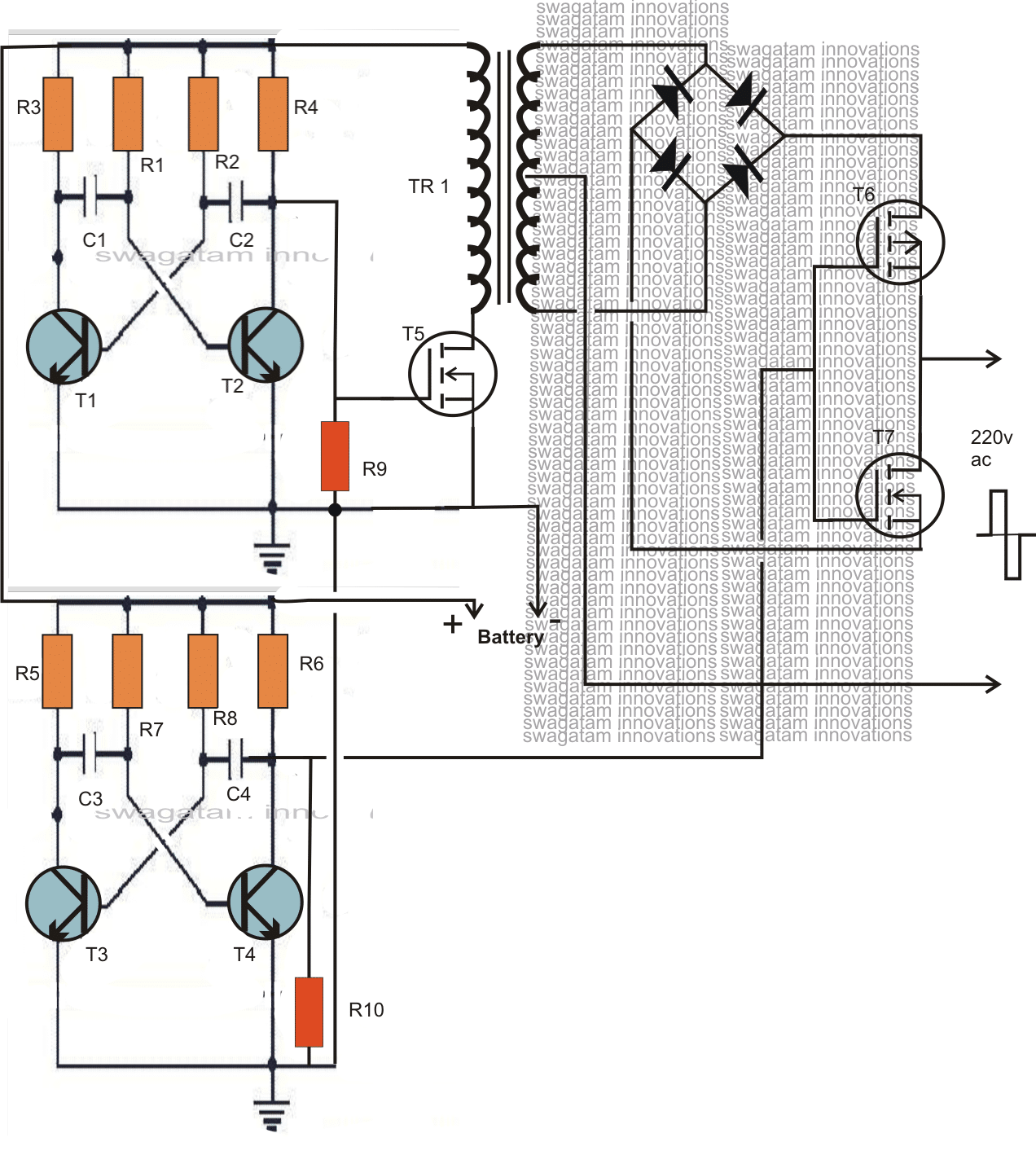

pls sir can you help with an oscillator circuit to drive a ferrite core inverter circuit with ic SG3525
hope to hear from you sir.
Power, a ferrite oscillator will need a frequency in the order of 20 to 50kHz which you can easily set in the IC by selecting the RC components appropriately
sir what’s the work of the SD
a positive on this will shut down the IC, otherwise this SD must be always connected to ground
I’m inspired by your clear presentation, thanks for this information .I am an enthusiast following your posts . I went to construct a 2 kva inverter for home usage, my challenge is how to mount its components on a board how do I get out of this.
thank you, I appreciate your however if you are new then you must begin with smaller inverters first and then attempt this complex design, the above design is not recommended for the newcomers
sir can i build 0 to 120 volts variable sinewave inverter
It may be possible by adding a variable feedback loop with the SD pin of the full bridge driver IC
Good day Mr swagatam. Please in the above ferrite core inverter, can I use the circuit for 1KVA/12V or 2KVA/24 V or is it only configured for 5K/60V
The power output will depend on the trafo, battery and mosfet specs…so you can adjust these accordingly to get any desired output level.
Is there any way to use 2153 instead of irs2453 because irs2453 isn’t available in my country? Please help me out if anyone has clue. I already built a working ferrite inverter by watching a video.
But its high frequency output. So, i want to make it 50Hz now.
check and compare the datasheets of the two ICs, if they match then you can replace them with each other
Hello sir, pls what would b d length of both d 5 turns on d primary 5 turns and that of 18 turns on d secondary, because u knw d E core ar of many different sizes.
Hello Yusuf, use E80 type large e cores
Pls….sir. how can I make this ferrite core inverter circuit become sine wave?
it can be slightly complex, you will need to chop the low side mosfet gates with PWM for that to happen
pls I would like to implement adding pwm at the lower side just as you said…. pls how will i go about it?
Sir,
Recently I was testing IRS2153 (Gate driver IC).
Initially I just connected 15 volts to VCC .
Connected proper resistor and capacitor to RT and CT pin.
I want to check the signals on HO and LO pins.
Instead of getting complementary pulses on HO and LO pins, I am getting same pulses on HO and LO pins.
Please help.
Swati, if the frequency set by Rt/Ct is above 2 Hz then you won’t be able to distinguish the complementary effect across the Ho/Lo, and it would seem like both are producing positive voltgaes at the same time…..therefore you may have to reduce the frequency to around 1 Hz or 0.5 Hz, and then check the results…
Will this work on 12volt
yes it will